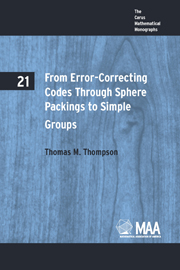Book contents
- Frontmatter
- PREFACE
- Contents
- CHAPTER 1 THE ORIGIN OF ERROR-CORRECTING CODES
- CHAPTER 2 FROM CODING TO SPHERE PACKING
- CHAPTER 3 FROM SPHERE PACKING TO NEW SIMPLE GROUPS
- APPENDIX 1 DENSEST KNOWN SPHERE PACKINGS
- APPENDIX 2 FURTHER PROPERTIES OF THE (24,12) GOLAY CODE AND THE RELATED STEINER SYSTEM S(5, 8, 24)
- APPENDIX 3 A CALCULATION OF THE NUMBER OF SPHERES WITH CENTERS IN Λ2 ADJACENT TO ONE, TWO, THREE AND FOUR ADJACENT SPHERES WITH CENTERS Λ2.
- APPENDIX 4 THE MATHIEU GROUP M24 AND THE ORDER OF M22
- APPENDIX 5 THE PROOF OF LEMMA 3.3
- APPENDIX 6 THE SPORADIC SIMPLE GROUPS
- BIBLIOGRAPHY
- INDEX
PREFACE
- Frontmatter
- PREFACE
- Contents
- CHAPTER 1 THE ORIGIN OF ERROR-CORRECTING CODES
- CHAPTER 2 FROM CODING TO SPHERE PACKING
- CHAPTER 3 FROM SPHERE PACKING TO NEW SIMPLE GROUPS
- APPENDIX 1 DENSEST KNOWN SPHERE PACKINGS
- APPENDIX 2 FURTHER PROPERTIES OF THE (24,12) GOLAY CODE AND THE RELATED STEINER SYSTEM S(5, 8, 24)
- APPENDIX 3 A CALCULATION OF THE NUMBER OF SPHERES WITH CENTERS IN Λ2 ADJACENT TO ONE, TWO, THREE AND FOUR ADJACENT SPHERES WITH CENTERS Λ2.
- APPENDIX 4 THE MATHIEU GROUP M24 AND THE ORDER OF M22
- APPENDIX 5 THE PROOF OF LEMMA 3.3
- APPENDIX 6 THE SPORADIC SIMPLE GROUPS
- BIBLIOGRAPHY
- INDEX
Summary
Back in 1947 Richard W. Hamming had access to a computer only on weekends. Some three decades later he recalled his frustration over its perverse behavior:
Two weekends in a row I came in and found that all my stuff had been dumped and nothing was done. … And so I said, ‘Damn it, if the machine can detect an error, why can't it locate the position of the error and correct it?’
[56, Tape 2]That question initiated the development of error-correcting codes. The offending computer, a mechanical relay model at Bell Telephone Laboratories, always came to an angry stop and switched to the next program whenever it detected an error. This behavior impelled Hamming, a pure mathematician with an applied bent, to devise the first error-correcting code.
We shall follow the devious trail that wends its way through a quarter-century of mathematics, starting with Hamming's work, which led almost immediately to that of M. J. E. Golay. The latter sparked, some twelve years later, giant steps in the packing of congruent spheres by John Leech, which, in turn, branched off through the work of J. H. Conway, into the field of simple groups. By tracing some of the twists, turns, switchbacks and dead ends of this path, we hope to provide a small window on the history of mathematics of the twentieth century. How historians ultimately will treat this golden age of mathematical creativity we cannot even guess.
- Type
- Chapter
- Information
- Publisher: Mathematical Association of AmericaPrint publication year: 1983
- 1
- Cited by



